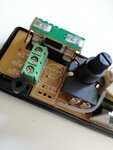stenzer
Advanced Member level 3
Hi,
can anyone give me an advice how to get rid of the annoying sound of a phase-fired controlled uplight?
The dimmer has the number HY-3360C. I already disassembled the circuitry. Below you can find a picture of the dimmer, the schematic and a Spice simulation.



I'm very thankfull for any tip, the noise drives me nuts :-?.
greets
can anyone give me an advice how to get rid of the annoying sound of a phase-fired controlled uplight?
The dimmer has the number HY-3360C. I already disassembled the circuitry. Below you can find a picture of the dimmer, the schematic and a Spice simulation.



I'm very thankfull for any tip, the noise drives me nuts :-?.
greets
